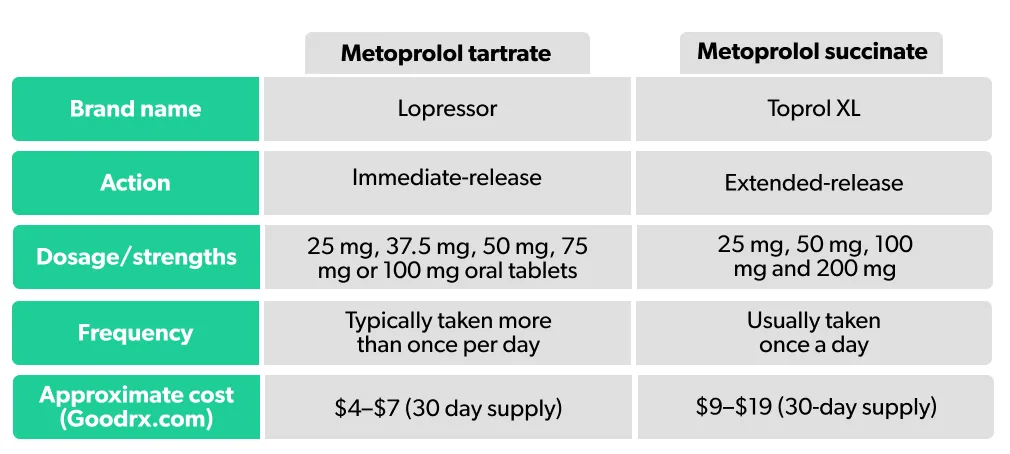Metoprolol succinate vs. metoprolol tartrate

Reviewed by Mike Bohl, MD, MPH, ALM,
Written by Chimene Richa, MD
last updated: Aug 21, 2020
6 min read
Here's what we'll cover
What are metoprolol succinate and metoprolol tartrate?
If you have heart problems, like high blood pressure or heart disease, your healthcare provider may have prescribed metoprolol for you. Metoprolol belongs to a class of medications called beta-blockers and comes in two main formulations: metoprolol succinate and metoprolol tartrate. Both contain the same medicine, but each has a different salt attached to the metoprolol molecule, causing them to behave somewhat differently.
Metoprolol succinate is a long-acting or extended-release form of metoprolol that you can take as a single daily dose. In contrast, metoprolol tartrate is a short-acting or immediate-release medication that can affect the body within one hour after taking it (DailyMed, 2018). Unfortunately, it not only acts quickly but is also broken down rapidly—most people usually take metoprolol tartrate twice a day.
Even though both metoprolol succinate and metoprolol tartrate are available in generic forms, you may be familiar with their brand names. Lopressor is the brand name for metoprolol tartrate, and Toprol XL is the brand name for metoprolol succinate.
What are metoprolol succinate and metoprolol tartrate used for?
While metoprolol succinate and metoprolol tartrate both belong to the beta-blocker category of medications, they are not necessarily used in the same way. Both the succinate and tartrate forms of metoprolol are FDA-approved to treat high blood pressure (hypertension) and chest pain due to heart disease (angina pectoris). However, they differ in their use for heart attack (myocardial infarction) and heart failure.
Metoprolol succinate is FDA-approved to treat stable, symptomatic, congestive heart failure (New York Heart Association Class II or III) (DailyMed, 2016). A large clinical trial, the MERIT-HF study, showed that metoprolol succinate improves outcomes and decreases the mortality rate of people with heart failure (MERIT-HF, 1999).
On the other hand, metoprolol tartrate has NOT been FDA-approved to treat heart failure. It has, however, been approved to treat people right after a definite or suspected heart attack (acute myocardial infarction). Metoprolol tartrate can decrease your risk of dying from a heart attack, especially if treatment is started 3 to 10 days after the event (DailyMed, 2016).
Some healthcare providers also use both forms of metoprolol “off-label” to treat conditions with faster than normal heart rates, like atrial fibrillation or atrial flutter. Another “off-label” use is to treat thyroid storm, a life-threatening condition in which you have much higher than normal levels of thyroid hormone. “Off-label” use means that the FDA did not specifically approve a drug for that particular purpose.
How do they work?
Metoprolol, along with other beta-blockers, decreases the workload on the heart. The succinate and tartrate forms of metoprolol both work the same way. They stop epinephrine (also known as adrenaline) from binding to beta receptors in your heart muscle, which results in your heart beating slower. Beating slower and squeezing less forcefully decreases how hard your heart has to work, which in turn, lowers your blood pressure and improves chest pain.
What are the side effects of metoprolol succinate and metoprolol tartrate?
Since both drugs contain the same medicine, metoprolol succinate and metoprolol tartrate have similar side effects. Both carry the same “black box” warning from the FDA—a black box calls to attention the most serious or life-threatening warnings about a drug.
Black box warning for metoprolol succinate and metoprolol tartrate: Do not abruptly stop taking metoprolol (succinate or tartrate). Stopping metoprolol suddenly may cause chest pain or heart attack (myocardial infarction). Your healthcare provider will help you decrease the dose gradually if you need to stop metoprolol (FDA, 2006).
Fortunately, most of the common side effects are mild and generally well-tolerated. Common side effects of both metoprolol succinate and metoprolol tartrate are similar. Still, the likelihood of having them varies slightly between the two forms of the medicine, as you can see in the table below (UpToDate, n.d).

*This is not an exclusive list. Talk to your healthcare provider about additional side effects.
The two forms of metoprolol also share the same serious side effects, including:
Slow heartbeat (bradycardia): A heart rate that is too low may cause fainting spells (syncope), dizziness, chest pains, fatigue, and confusion.
Low blood pressure (hypotension): Blood pressure that drops too low can cause dizziness, fainting, blurred vision, fatigue, shallow breathing, rapid pulse, and confusion. Severely low blood pressure is a life-threatening emergency. Your blood pressure may drop only after standing up from a sitting or laying down position—this is called orthostatic hypotension.
Worsening
Masking of hypoglycemic symptoms: Metoprolol can block the signals of low blood sugar, including shakiness, anxiety, confusion, rapid heartbeat (palpitations), and lightheadedness. If your blood sugars are too low for too long, it can lead to seizures, unconsciousness, and even death in rare cases.
Heart block: Metoprolol can cause heart block, which leads to an irregular heartbeat (arrhythmia).
Metoprolol tartrate has the additional serious side effect of potentially worsening heart failure. Over 27% of people taking metoprolol tartrate noticed worsening of their heart failure symptoms (DailyMed, 2018).
This list does not include all possible side effects and others may occur. Get medical advice from your pharmacist or healthcare provider for more information.
Which drugs interact with metoprolol succinate or metoprolol tartrate?
Before starting metoprolol succinate or metoprolol tartrate, seek medical advice about potential drug interactions. Medicines that may interact with both forms of metoprolol include (DailyMed, 2018):
Monoamine oxidase inhibitors (These drugs may increase the effects of metoprolol and can potentially increase side effects; examples include isocarboxazid, phenelzine, selegiline, and tranylcypromine.
CYP2D6 system inhibitors: Since the CYP2D6 system in the liver breaks down metoprolol, other drugs that interfere with this system may affect its metabolism. This could lead to higher than normal levels of metoprolol circulating in your bloodstream, which increases your risk of side effects. Examples of these medications include quinidine, fluoxetine (brand name Prozac; see Important Safety Information), paroxetine (brand name Brisdelle; see Important Safety Information), and propafenone.
Medications that lower heart rate: Since metoprolol lowers the heart rate, combining it with other drugs with the same effect increases your risk of having a very slow heart rate (bradycardia). Examples include digoxin, clonidine, and the calcium channel blockers diltiazem and verapamil.
Sildenafil citrate Metoprolol may cause more of a drop in blood pressure if taken with PDE5 inhibitors.
Alcohol has a potential drug interaction with metoprolol succinate, but not metoprolol tartrate. Metoprolol succinate has an extended-release action that, when combined with alcohol, may not function properly. Alcohol can speed up the action of the drug and release metoprolol into your system faster than intended
This list does not include all possible drug interactions with metoprolol and others may exist. Check with your pharmacist or healthcare provider for more information.
Who should not use metoprolol succinate or metoprolol tartrate?
Certain groups of people should avoid using metoprolol succinate or metoprolol tartrate, or use these medications with caution. Overall, these groups are the same for both forms of metoprolol. People with heart failure should be cautious when taking metoprolol tartrate because of the potential for worsening symptoms. Metoprolol succinate, while FDA-approved to treat heart failure, can still lead to worsening heart failure symptoms if the dose is increased too quickly. Other groups who should avoid or be careful with metoprolol include (UpToDate, n.d.):
People with asthma
People with diabetes
People with a slow heart rate (bradycardia) or low blood pressure (hypotension)
Pregnant women or women who are breastfeeding: According to the FDA, both metoprolol succinate and metoprolol tartrate are pregnancy category C—there is not enough information to determine the risk to the pregnancy (FDA, 2006). Even though metoprolol has been measured in small quantities in breastmilk, no adverse effects have been reported. Women and their healthcare providers should weigh the risks and benefits of the medication (FDA, 2006).
People with liver disease: If your liver is not functioning normally, it may not be able to break down metoprolol well. Liver problems can cause higher than expected levels of metoprolol in the body. You may need to take a lower dose of metoprolol (DailyMed, 2018).
People with an overactive thyroid (hyperthyroidism): Metoprolol can mask the signs of high thyroid hormone levels, like a fast heart rate (tachycardia), and stopping the drug abruptly can lead to a thyroid storm (dangerously high thyroid hormone levels) (DailyMed, 2016).
This list does not include all at-risk groups and others may exist. Talk to your pharmacist or healthcare provider for more information.
Dosage for metoprolol succinate and metoprolol tartrate
Metoprolol succinate comes in extended-release pills. Metoprolol tartrate comes in immediate-release tablets and as an injectable intravenous solution. Most insurance plans cover both forms. The following table illustrates the different doses available of the two types of metoprolol:
Metoprolol tartrate | metoprolol succinate | |
|---|---|---|
Brand name | Lopressor | Toprol XL |
Action | Immediate-release | Extended-release |
Dosage/strengths | 25 mg, 37.5 mg, 50 mg, 75 mg, or 100 mg oral tablets | 25 mg, 50 mg, 100 mg, and 200 mg |
Frequency | Typically taken more than once per day | Usually taken once a day |
Approximate cost (Goodrx.com) | $4-$7 (30-day supply) | $9-$19 (30-day supply) |

DISCLAIMER
If you have any medical questions or concerns, please talk to your healthcare provider. The articles on Health Guide are underpinned by peer-reviewed research and information drawn from medical societies and governmental agencies. However, they are not a substitute for professional medical advice, diagnosis, or treatment.
DailyMed. (2018). Metoprolol tartrate tablet, film coated. Retrieved on Aug. 19, 2020 from https://dailymed.nlm.nih.gov/dailymed/drugInfo.cfm?setid=809c6386-0039-42ff-a03e-e42733e229b8
DailyMed. (2016). Toprol XL, Metoprolol succinate tablet, film coated. Retrieved on Aug. 19, 2020 from https://dailymed.nlm.nih.gov/dailymed/drugInfo.cfm?setid=4a5762c6-d7a2-4e4c-10b7-8832b36fa5f4#williamsonbk1264649625548
MERIT-HF Study Group. (1999). Effect of metoprolol CR/XL in chronic heart failure: Metoprolol CR/XL Randomised Intervention Trial in Congestive Heart Failure (MERIT-HF). Lancet , 353(9169), 2001–2007. Retrieved from https://pubmed.ncbi.nlm.nih.gov/10376614/
UpToDate. (n.d.). Metoprolol: Drug Information. Retrieved on Aug. 19, 2020 from https://www.uptodate.com/contents/metoprolol-drug-information?search=metoprolol&source=panel_search_result&selectedTitle=1~148&usage_type=panel&kp_tab=drug_general&display_rank=1#F195759
U.S. Food and Drug Administration (FDA). (2006). Metoprolol succinate, extended-release tablets. Retrieved on Aug. 12, 2020 from https://www.accessdata.fda.gov/drugsatfda_docs/label/2006/019962s032lbl.pdf










